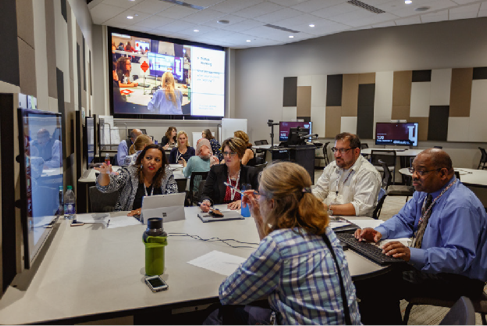History of Active Learning Classrooms
To leverage the benefits of face-to-face learning, learning space design requires considerations of pedagogy, space, and technology (Radcliffe, 2008). Active Learning Classrooms (ALCs) are one approach that universities and colleges consider when creating or remodeling learning spaces. ALCs feature movable furniture, accessible whiteboard space, and technology enhancements with various designs and configurations (Beichner et al., 2007; Dori & Belcher 2005; Parsons, 2016; Whiteside, Brooks, & Walker, 2010). ALCs are intended to support students’ active interaction, engagement, and problem- solving skill development (Baepler et al., 2016; Beichner, 2014; Parsons, 2016). The affordances of ALCs promote collaborative, active, and student-centered learning, which emphasizes social interaction in knowledge construction (Dillenbourg, 1999; Littleton & Ha¨kkinen, 1999; Palincsar, 1998). The learning approaches that are supported by ALCs include cooperative learning (Johnson & Johnson, 2009), team-based learning (Michaelsen, Knight, & Fink, 2002), collaborative project-based learning (Bell, 2010; Blumenfeld et al., 1991), and collaborative problem-based learning (Barrows & Tamblyn, 1980; Hmelo- Silver, 2004; Savery, 2006).
Comparative studies from early initiatives such as North Carolina State University’s SCALE-UP, the University of Minnesota’s PAIR- UP, and Massachusetts Institute of Technology’s (MIT’s) TEAL initiative show that students have positive learning outcomes in ALCs (Beichner et al., 2007; Brooks, 2012; Dori & Belcher, 2005). As a result, the number of higher education institutions that adopt active learning classrooms is increasing (Beichner & Cevetello, 2013). More than 200 U.S. institutions currently have ALCs (Beichner, 2014).
MOSAIC INITIATIVE
Indiana University’s Mosaic Active Learning Initiative supports innovative classroom design, research, and comprehensive support for all IU classrooms. The Mosaic Initiative started in fall 2015 and publicly launched at IU Bloomington in January 2016 (Morrone et al., 2017). In September 2016, the Mosaic Initiative expanded to the Indiana University-Purdue University Indianapolis (IUPUI) campus.

As the name of the initiative suggests, the Mosaic Initiative supports a variety (mosaic) of classroom designs rather than encouraging a single-configuration approach, such as North Carolina State University’s SCALE-UP.
MOSAIC FACULTY FELLOWS
The Faculty Fellows program is a core component of the Mosaic Initiative. The program provides an opportunity, over the course of a full academic year, for faculty to engage in active learning practices in their own teaching and with other Mosaic Fellows, as well as contribute to the development of learning spaces across Indiana University. The first cohort of IUPUI Mosaic Fellows was formally selected in 2016.
Goals of Mosaic Faculty Fellows:
- Prepare faculty to teach in active learning spaces by exploring various instructional strategies and approaches
- Build a community of faculty members who collaborate on their own teaching and mentor colleagues on exploring and refining pedagogical practices
- Promote evidence-based teaching through the encouragement of research on teaching and learning activities in ALCs
- Create faculty leaders to guide the development of new learning spaces on campus

For faculty members who teach in active learning classrooms but are not part of the Mosaic Faculty Fellows program, can participate in the following offerings through the Mosaic initiative:
- Mosaic classroom workshops
- Open classroom sessions to observe actual courses in Mosaic classrooms
- Interactive tours of a variety of active learning classrooms to explore different designs and technologies
- One-on-one or group consultations (on request)
ACTIVE LEARNING CLASSROOMS AT IUPUI
As of summer 2018, there are 18 Mosaic Active Learning Environments and 12 Mosaic technology-enhanced classrooms for instructor and student use (out of a 188 classrooms total at IUPUI). The capacity of these classrooms varies. The Mosaic designated rooms can accommodate 20 to 106 students, with most rooms serving 20 to 54 students; the Mosaic technology enhanced classrooms accommodate a range of 20 to 54 students. The Mosaic Active Learning Environments at IUPUI are equipped with movable chairs and movable tables, whereas the Mosaic technology-enhanced classrooms have more fixed seating arrangements, such as large circular tables, lab configurations with monitors that can be lowered, or U-shaped collaborative tables with large wall-mounted monitors for sharing of small group work. Both types of learning environments include whiteboards, projection screens, and accessible power outlets for charging of electronic devices.

